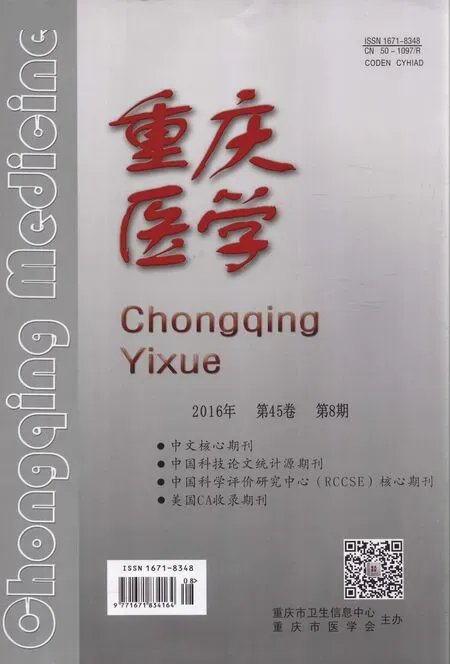针对Th17细胞及IL-17的靶向生物制剂在类风湿关节炎的研究进展
任 茜 综述,何成松 审校
(泸州医学院风湿免疫科,四川泸州 646000)
针对Th17细胞及IL-17的靶向生物制剂在类风湿关节炎的研究进展
任茜 综述,何成松△审校
(泸州医学院风湿免疫科,四川泸州 646000)
[关键词]类风湿关节炎;Th17细胞;IL-17;生物制剂
类风湿关节炎(rheumatoid arthritis,RA)是一个慢性自身免疫性疾病,以关节炎症和滑膜增生为主要特点,常导致骨及软骨的破坏,有较高的致残率,严重影响功能活动及生活质量[1]。其发病机制尚不明确,目前研究认为辅助性T细胞17(T help cell 17,Th17)及产生的白细胞介素-17(IL-17)在RA发病机制中有关键作用。传统的改善病情抗风湿药(DMARDS)及肿瘤坏死因子-α(TNF-α)拮抗剂能有效的治疗RA,但仍有许多患者对其不耐受或反应不佳。而针对Th17细胞及IL-17的靶向生物制剂为RA的治疗提供了新的方向。
1Th17细胞
Th17细胞是一类重要的介导炎性反应的细胞,在自身免疫性疾病及机体防御反应中起着重要作用。并且,它主要分泌IL-17、IL-6、IL-21、IL-22等细胞因子,已有许多的研究证明Th17细胞在RA慢性炎症及随后的关节损伤中有至关重要的作用[2]。原始CD4+T细胞可分化成Th1、Th2、Th17、调节性T细胞(Treg)等不同细胞亚群,这受特定细胞因子环境的影响。Annunziato等[3]认为,人类Th17细胞的分化可能是在炎性细胞因子如:IL-6、IL-21、IL-23存在的情况下,转化生长因子-β(TGF-β)激活转录因子维甲酸相关孤核受体(RORC),诱导分化形成。IL-1β及IL-6促进Th17的扩增;IL-23促进其进一步增殖及稳定。Th17细胞的分化受众多细胞因子网络及炎症环境的影响。研究发现,微生物菌群可通过特定的Toll样受体(Toll-like receptors,TLRs)提供一个初始的促炎信号来启动细胞因子的产生和Th17细胞的分化[4]。一种新型的肿瘤坏死因子(TNF)家族成员——肿瘤坏死因子样凋亡微弱诱导剂(tumornecrosis factor-like weak inducer of apoptosis,TWEAK),可能通过结合Fn-14信号通路诱导Th17细胞分化及IL-17的表达,驱动炎性反应的扩大[5]。最近,TL1A(TNF-like cytokine,TNFSF15)也被确认为TNF家族成员,它能促进TGF-β和IL-6诱导Th17细胞的分化,促进RORC mRNA的表达,增加RA患者血清IL-17A水平[6]。
2Th17/Treg平衡与RA
原始CD4+T细胞在RA发病机制中占中心地位,过去认为Th1/Th2细胞失衡是RA主要发病机制。根据目前假说[7],Th1/Th2平衡及Th17/Treg平衡共同参与RA发病,而后者有更为重要的作用。所以,通过调节Th17/Treg平衡,可达到免疫调节作用。而RA患者血清中高水平的IL-17使研究人员更为关注细胞因子对Th17/Treg平衡的影响[8]。
3IL-17与RA
IL-17家族有6个成员(IL-17A、IL-17B、IL-17C、IL-17D、IL-17E、IL-17F),目前研究较多的是IL-17A,其余的研究尚少。IL-17是Th17细胞分泌的特征性细胞因子,参与宿主防御反应,并且在RA发病机制中扮演重要角色[9]。IL-17高表达于RA患者滑膜液及血清,且与疾病活动性及严重程度有一定相关性。在RA发病早期,IL-17刺激成纤维滑膜细胞产生血管内皮生长因子(vascular endothelial growth factor,VEGF)促进血管生成[10]。并且,通过介导磷酸肌醇3激酶(PI3K)信号通路激活,诱导血管内皮细胞迁移和血管形成[11]。IL-17能驱动单核细胞的募集,促进TNF-α、IL-6、IL-1β等炎性细胞因子及趋化因子CCL2和CCL20的表达,促进关节炎性反应[12]。更重要的是,在IL-17的作用下,滑膜细胞及软骨细胞基质金属蛋白酶(MMPs)的过度表达,导致软骨降解,进而出现软骨损伤。而IL-17也可通过刺激核因子-κB(NF-κB)受体激动剂(RANKL)的表达,破坏RANKL/骨保护素平衡,刺激破骨细胞生成和骨侵蚀[13]。然而,IL-17不是孤立的一个细胞因子,它能与其他细胞因子形成错综复杂的细胞因子网络参与RA的发病。如:IL-17A协同TNF-α通过上调S100A8、MMPs、IL-1β的表达,明显增强关节炎症和损伤,造成不可逆的软骨损害[14]。
4针对Th17细胞及IL-17的靶向生物制剂在RA治疗中的临床研究
在RA的治疗上,DMARDS使许多患者受益。然而,随着对RA发病的细胞和分子机制研究的深入,出现了一类新型治疗方法——生物制剂,当前生物治疗的主流是TNF-α拮抗剂。尽管这大大改善了许多RA患者预后,但仍有许多患者对其不耐受或治疗效果欠佳。研究表明[15],对TNF-α拮抗剂无应答的RA患者Th17细胞数量明显高于对TNF-α拮抗剂有应答者。这表明,Th17细胞及相关细胞因子可能为RA治疗提供新方向。
4.1针对Th17细胞的靶向生物制剂的临床研究Th17细胞的分化受众多细胞因子的调控,靶向阻断这些细胞因子,可以抑制Th17细胞的分化及增殖,降低Th17细胞水平,减轻RA患者严重程度。
4.1.1托珠单抗(Tocilizumab,TCZ)TCZ是重组人源化抗IL-6R单克隆抗体,通过与IL-6R结合,抑制IL-6介导的信号通路。IL-6是Th17细胞分化重要的细胞因子,通过阻断这种细胞因子途径可减少Th17细胞水平,抑制其分化[16]。目前许多临床试验证明了TCZ是治疗RA的一种有效药物。有一项纳入了10篇发表在PubMed及Charane图书馆的TCZ的系统回顾试验,结果表明[17]:相比单用甲氨蝶呤(MTX),单用TCZ能取得更好的疗效;对MTX及TNF拮抗剂反应不充分的患者,TCZ联合MTX能取得更高的ACR20(ACR,美国风湿病学会制定的类风湿关节炎病情改善标准)反应率。Bay-Jensen等[18]认为,TCZ联合MTX治疗RA,不影响骨密度,能降低血清DKK-1(Dickkopf-1)水平,促进骨形成。因此,TCZ在全世界90多个国家已被批准用于RA治疗。TCZ在RA患者中耐受性良好,但在老年患者中可能缺乏有效性[19]。有研究表明,对MTX不耐受患者,单用TCZ优于单用阿达木单抗[20]。
4.1.2托法替尼(Tofacitinib,JAK3抑制剂)Tofacitinib是一种新型的口服小分子JAK激酶抑制剂,能阻断JAK/STAT信号通路,也能抑制T细胞的增殖和原始T细胞向Th17细胞分化[21]。有临床研究表明[22],对TNF抑制剂反应不佳的RA患者,接受Tofacitinib联合MTX治疗后,ACR20百分比增加,且健康评估问卷-残疾指数量表(HAQ-DI)、疾病活动度(DAS)评分较安慰剂组有显著差异。有一项纳入了8个临床试验(4个Ⅱ期试验,4个Ⅲ期试验)的系统回顾试验,旨在评估Tofacitinib治疗RA的疗效及安全性。试验结果表明[23]:Tofacitinib在3 mg以上剂量组ACR20百分比明显增高;且不管单用或连用MTX,Tofacitinib在5、10 mg组能明显改善患者临床症状。其疗效类似于阿达木单抗,常见不良反应主要为:感染、中性粒细胞减少,高密度脂蛋白胆固醇、低密度脂蛋白胆固醇增高等。这是一种有前途的药物,且口服用药方便,减少了注射带来的皮肤刺激等不良反应。
4.1.3其他药物此外,许多药物如:MTX、Anakinara、美罗华(Ritaximab)已长期应用于RA治疗中,他们被证实对Th17细胞水平有影响。
Ritaximab是针对B淋巴细胞(CD20)的人鼠嵌合单克隆抗体,为治疗RA提供新的靶向目标。它能抑制Th17细胞的增殖及分化,减少IL-17、IL-21、IL-22的生成[24]。研究发现[25],对TNF拮抗剂及DMARDs反应不佳的活动性RA患者,Ritaximab联用MTX与Ritaximab联用来氟米特临床疗效无明显差异,这为对MTX有禁忌RA患者的治疗提供新的方向。阿那白滞素(Anakinara)是IL-1R拮抗剂,它通过与IL-1R结合阻断IL-1信号转导,从而减少关节炎症。不管单用或联用MTX治疗活动性RA,疗效及耐受性良好[26]。且研究发现[27],联用MTX治疗RA,促进了调节性T细胞比例升高,降低了Th17细胞水平及血清IL-17、IL-21水平。然而,并不是所有试图通过抑制Th17细胞分化而减少RA关节炎严重程度都如上诉药物有效。比如STA-5326是一种口服小分子,它能抑制IL-23和IL-12的产生;在Ⅱa期随机双盲概念验证试验中,STA-5326联合MTX治疗活动性RA,不能明显增加ACR20百分比,且增加剂量不能改善临床疗效[28]。
众多的临床研究显示了这些生物制剂治疗RA的优势,并且为对MTX及TNF拮抗剂反应不佳的RA患者提供了新的方向,然而,需要更为长期的数据来描述这些药物治疗RA的风险及收益。
4.2IL-17A抑制剂的临床研究针对IL-17A的生物制剂目前正在临床研究中,主要包括:Ixekizumab(LY2439821)、Secukinumab(AIN457)和Brodalumab(AMG-827)。他们通过中和IL-17/IL-17R,能改善RA患者临床症状,抑制关节炎严重程度。
4.2.1Ixekizumab(LY2439821)Ixekizumab是一个人源化IgG4抗IL-17单克隆抗体。研究表明[29],RA患者在传统DMARDs治疗基础上,予以LY2439821,能明显提高ACR20、ACR50、ACR70百分比,降低DAS28基线水平。随后的一项Ⅱ期临床试验中,设置为生物制剂初治组及对TNF拮抗剂反应不佳组,分别予以不同剂量的Ixekizumab及安慰剂。结果显示[30],生物制剂初治组中,30 mg的Ixekizumab相比安慰剂组,能明显改善ACR20百分比;在TNF-IR组中,相比安慰剂,只有80 mg及以上的高剂量组能明显提高ACR20百分比。两组的疾病活动度-C反应蛋白(DAS28-CRP)、临床疾病活动指数(CDAI)、CRP较安慰剂有显著差异。且它的安全性与其他生物制剂相似,没有严重不安全问题。
4.2.2Secukinumab(AIN457)Secukinumab是一个全人源化IgG1K抗IL-17A单克隆抗体。Secukinumab能明显提高RA患者ACR20百分比,降低DAS28及CRP水平,减少滑膜炎症,改善临床症状[31]。在一项Ⅱ期试验中[32],对MTX反应不佳的RA患者接受不同剂量的Secukinumab(16周作为主要评估点),也证实了上诉结果,且发现75 mg以上剂量组能明显降低DAS28-CRP及血清CPR水平。随即,一系列规模更大,历时更久的临床试验陆续开展。在上述试验基础上,16周时ACR20有应答者继续接受同样起始剂量,直至52周;没有应答者加大剂量。结果显示[33],对Secukinumab有效者经过52周持续有效,无应答者,随剂量加大无明显收益。Secukinumab治疗引起的不良事件大多数为轻至中度,且与安慰剂组无明显差异。
4.2.3Brodalumab(AMG-827)Brodalumab是一个针对IL-17受体的全人源化单克隆抗体。它应用于银屑病关节炎治疗中能明显增加ACR20、ACR50百分比[34],也用于治疗RA及其他免疫炎症疾病,但研究尚少。Martin等[35]的试验中,对MTX反应不佳的RA患者,接受Brodalumab治疗后ACR20百分比增加,药物不良反应与剂量递增无明显关系,不良事件发生率较安慰剂无明显差异。但该试验为Ⅰb期试验,安全性是主要评估点,需要更多的Ⅱ期试验来评估其疗效及安全性。
IL-17在宿主防御反应中有重要作用,所以它的抑制剂有潜在引发严重感染和介导免疫性疾病的风险。但是,阻断众多细胞因子网络中的一些细胞因子,对于引发感染风险较小。上诉药物的临床试验报告一般耐受性良好,但这些试验持续时间较短,仍需更进一步临床试验来评估更长期的疗效及安全性。
5结语与展望
随着对RA研究的深入,Th17细胞及IL-17在RA的作用受到重视。针对Th17细胞及IL-17的靶向生物制剂通过减少Th17细胞及IL-17水平,能有效减轻关节炎症及疾病严重程度,为RA的治疗提供了新的方向,并且显示出较传统DMARDS及TNF-α药物的优势。但是,这些药物临床研究时间较短,且并没有阐明RA患者能从中受益多大,什么剂量或什么给药方案最为合理。所以,仍需要更多的数据来评估更为长期的收益及风险。
参考文献
[1]Weyand CM.New insights into the pathogenesis of rheumatoid arthritis[J].Rheumatology,2000,39(1):3-8.
[2]Hemdan NY,Birkenmeier G,Wichmann G,et al.Interleukin-17-producing T helper cells in autoimmunity[J].Autoimmun Rev,2010,9(11):785-792.
[3]Annunziato F,Romagnani S.Heterogeneity of human effector CD4+T cells[J].Arthritis Res Ther,2009,11(6):1-8.
[4]Van Den Berg WB,Mcinnes IB.Th17 cells and IL-17 A-Focus on immunopathogenesis and immunotherapeutics[J].Semin Arthritis Rheum,2013,43(2):158-170.
[5]Park JS,Park MK,Lee SY,et al.TWEAK promotes the production of Interleukin-17 in rheumatoid arthritis[J].Cytokine,2012,60(1):143-149.
[6]Zhou M,Liu R,Su DL,et al.TL1A increased the differentiation of peripheral Th17 in rheumatoid arthritis[J].Cytokine,2014,69(1):125-130.
[7]Wang W,Shao S,Jiao Z,et al.The Th17/Treg imbalance and cytokine environment in peripheral blood of patients with rheumatoid arthritis[J].Rheumatol Int,2012,32(4):887-893.
[8]Al-Zifzaf DS,El BA,Mamdouh R,et al.FoxP3+T regulatory cells in Rheumatoid arthritis and the imbalance of the Treg/TH17 cytokine axis[J].Egyp Rheumatol,2015,37(1):7-15.
[9]Ishigame H,Kakuta S,Nagai T,et al.Differential roles of interleukin-17a and-17F in host defense against mucoepithelial bacterial infection and allergic responses[J].Immunity,2009,30(1):108-119.
[10]Ryu S,Lee JH,Kim SI.IL-17 increased the production of vascular endothelial growth factor in rheumatoid arthritis synoviocytes[J].Clin Rheumatol,2006,25(1):16-20.
[11]Pickens SR,Volin MV,Mandelin AM,et al.IL-17 contributes to angiogenesis in rheumatoid arthritis[J].J Immunol,2010,184(6):3233-3241.
[12]Shahrara S,Pickens SR,Mandelin IA,et al.IL-17-Mediated monocyte migration occurs partially through CC chemokine ligand 2/monocyte chemoattractant protein-1 induction[J].J Immunol,2010,184(8):4479-4487.
[13]Lubberts E,Van Den Bersselaar L,Oppers-Walgreen BA,et al.IL-17 promotes bone erosion in murine collagen-induced arthritis through loss of the receptor activator of NF-kappa B ligand/osteoprotegerin balance[J].J Immunol,2003,170(5):2655-2662.
[14]Koenders MI,Marijnissen RJ,Devesa IA,et al.Tumor necrosis Factor-Interleukin-17 interplay induces S100A8,interleukin-1 beta,and matrix metalloproteinases,and drives irreversible cartilage destruction in murine arthritis rationale for combination treatment during arthritis[J].Arthritis Rheum,2011,63(8):2329-2339.
[15]Chen DY,Chen YM,Chen HH,et al.Increasing levels of circulating Th17 cells and interleukin-17 in rheumatoid arthritis patients with an inadequate response to anti-TNF-alpha therapy[J].Arthritis Res Ther,2011,13(4):R126.
[16]Samson M,Audia S,Janikashvili N,et al.Brief report:inhibition of interleukin-6 function corrects Th17/Treg cell imbalance in patients with rheumatoid arthritis[J].Arthritis Rheum,2012,64(8):2499-2503.
[17]Navarro-Millan I,Singh JA,Curtis JR.Systematic review of tocilizumab for rheumatoid arthritis:a new biologic agent targeting the interleukin-6 receptor[J].Clin Ther,2012,34(4):788-802.
[18]Bay-Jensen AC,Platt A,Byrjalsen I,et al.Effect of tocilizumab combined with methotrexate on circulating biomarkers of synovium,cartilage,and bone in the LITHE study[J].Semin Arthritis Rheum,2014,43(4):470-478.
[19]Pers YM,Schaub R,Fortunet C,et al.Efficacy and sfety of tocilizumab in elderly patients with rheumatoid arthritis[J].Ann Rheum Dis,2014,73(2):689.
[20]Gabay C,Emery P,Van Vollenhoven R,et al.Tocilizumab monotherapy versus adalimumab monotherapy for treatment of rheumatoid arthritis (ADACTA):a randomised,double-blind,controlled phase 4 trial[J].Lancet,2013,381(9877):1541-1550.
[21]Maeshima K,Yamaoka K,Kubo S,et al.The JAK inhibitor tofacitinib regulates synovitis through inhibition of interferon-gamma and interleukin-17 production by human CD4+T cells[J].Arthritis Rheum,2012,64(6):1790-1798.
[22]Burmester GR,Blanco R,Charles-Schoeman C,et al.Tofacitinib(CP-690,550)in combination with methotrexate in patients with active rheumatoid arthritis with an inadequate response to tumour necrosis factor inhibitors:a randomised phase 3 trial[J].Lancet,2013,381(9865):451-460.
[23]Kaur K,Kalra S,Kaushal S.Systematic review of tofacitinib:a new drug for the management of rheumatoid arthritis[J].Clin Ther,2014,36(7):1074-1086.
[24]Van De Veerdonk FL,Lauwerys B,Marijnissen RJ,et al.The anti-CD20 antibody rituximab reduces the Th17 cell response[J].Arthritis&Rheumatism,2011,63(6):1507-1516.
[25]Narvaez J,Diaz-Torne C,Miguel Ruiz J,et al.Comparative effectiveness of rituximab in combination with either methotrexate or leflunomide in the treatment of rheumatoid arthritis[J].Semin Arthritis Rheum,2011,41(3):401-405.
[26]Furst DE.Anakinra:review of recombinant human interleukin-I receptor antagonist in the treatment of rheumatoid arthritis[J].Clin Ther,2004,26(12):1960-1975.
[27]Niu XY,He DY,Deng SH,et al.Regulatory immune responses induced by IL-1 receptor antagonist in rheumatoid arthritis[J].Mol Immunol,2011,49(1/2):290-296.
[28]Krausz S,Boumans MJ,Gerlag DM,et al.A phase Ⅱa,randomized,double-blind,placebo-controlled trial of apilimod mesylate,an interleukin-12/interleukin-23 inhibitor,in patients with rheumatoid arthritis[J].Arthritis Rheum,2012,64(6):1750-1755.
[29]Genovese MC,Van Den Bosch F,Roberson SA,et al.LY2439821,a humanized Anti-Interleukin-17 monoclonal antibody,in the treatment of patients with rheumatoid arthritis a phase Ⅰ randomized,Double-Blind,Placebo-Controlled,Proof-of-Concept study[J].Arthritis Rheum,2010,62(4):929-939.
[30]Genovese MC,Greenwald M,Cho CS,et al.A phase Ⅱ randomized study of subcutaneous ixekizumab,an Anti-Interleukin-17 monoclonal antibody,in rheumatoid arthritis patients who were naive to biologic agents or had an inadequate response to tumor necrosis factor inhibitors[J].Arthritis Rheumatol,2014,66(7):1693-1704.
[31]Hueber W,Patel DD,Dryja TA,et al.Effects of AIN457,a fully human antibody to interleukin-17a,on psoriasis,rheumatoid arthritis,and uveitis[J].Sci Transl Med,2010,2(52):7130-7135.
[32]Genovese MC,Durez P,Richards HB,et al.Efficacy and safety of secukinumab in patients with rheumatoid arthritis:a phase II,dose-finding,double-blind,randomised,placebo controlled study[J].Ann Rheum Dis,2013,72(6):863-869.
[33]Genovese MC,Durez P,Richards HB,et al.One-year Efficacy and Safety Results of Secukinumab in Patients With Rheumatoid Arthritis:Phase II,Dose-finding,Double-blind,Randomized,Placebo-controlled Study[J].J Rheumatol,2014,41(3):414-421.
[34]Mease PJ,Genovese MC,Greenwald MW,et al.Brodalumab,an Anti-IL17RA monoclonal antibody,in psoriatic arthritis[J].N Engl J Med,2014,370(24):2295-2306.
[35]Martin DA,Churchill M,Felipe Flores-Suarez L,et al.A phase Ib multiple ascending dose study evaluating safety,pharmacokinetics,and early clinical response of brodalumab,a human anti-IL-17R antibody,in methotrexate-resistant rheumatoid arthritis[J].Arthritis Res Ther,2013,15(5):R164.
doi:·综述·10.3969/j.issn.1671-8348.2016.08.042
作者简介:任茜(1989-),硕士在读,住院医师,主要从事风湿免疫临床工作。△通讯作者,E-mail:13700980878@163.com。
[中图分类号]R593.22
[文献标识码]A
[文章编号]1671-8348(2016)08-1124-04
(收稿日期:2015-07-22修回日期:2015-12-15)

